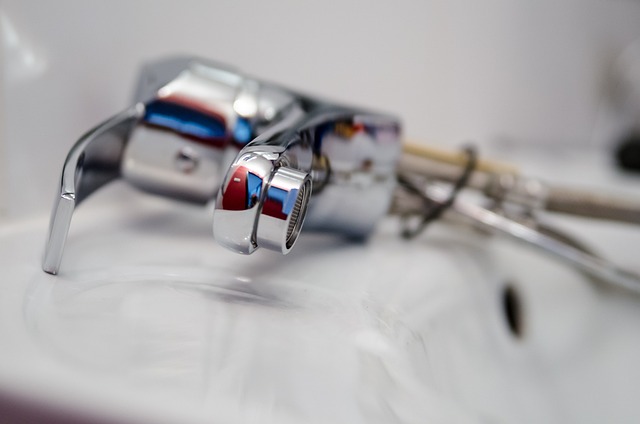Maintaining your home's plumbing system requires regular checks and prompt repairs to prevent issues. Key components like washers, valves, and seals are prone to wear from friction, mineral buildup, and degradation over time. Homeowners should watch for signs such as water discoloration, pressure fluctuations, and unusual sounds that indicate potential failure of these parts. When such signs are detected, it's advisable to call a professional plumber for an inspection and necessary repairs or replacements to avoid more serious problems. A qualified plumber can ensure the system operates efficiently and maintain its long-term integrity by checking these components and performing maintenance as needed.
For DIY enthusiasts, replacing a worn-out washer in a faucet can be done by cutting off the water supply, emptying the faucet, removing the handle or cap, cleaning the valve seat, installing a new washer that matches the old one, and reassembling the faucet. However, for complex issues involving worn-out valves, it's best to hire a licensed plumber to perform precise replacements, ensuring no leaks or compromised system performance. The plumber will carefully remove the old valve, inspect the piping for damage, install the new valve according to manufacturer specifications, and conduct pressure tests to verify the repair's success. This meticulous process by a professional plumber is essential for maintaining an efficient, durable plumbing system. Regular maintenance and quick responses to signs of wear are key to preventing larger issues in your home's plumbing infrastructure.
Addressing worn-out washers, valves, and seals in your plumbing system is a critical task for maintaining home functionality and preventing water leaks. This article serves as a comprehensive guide, equipping you with the knowledge to identify issues, step-by-step replacement techniques for faucets, fixtures, and valves, and methods to seal components effectively. While some plumbing repairs are straightforward, complex issues may necessitate professional plumber intervention. Dive into this piece to master DIY plumbing maintenance or learn when it’s best to call in an expert to ensure your home’s water systems operate smoothly.
- Identifying Worn-Out Washers, Valves, and Seals in Your Plumbing System
- Step-by-Step Guide to Replacing Washers in Faucets and Fixtures
- How to Replace Worn-Out Valves in Your Plumbing Network: A Detailed Approach
- Techniques for Sealing the Deal: Replacing Old Seals in Various Plumbing Components
- When to Call a Professional Plumber for Washer, Valve, or Seal Replacement
Identifying Worn-Out Washers, Valves, and Seals in Your Plumbing System

When your plumbing system is functioning optimally, it’s easy to overlook its components. However, washers, valves, and seals are critical parts that maintain water flow and prevent leaks. Over time, these components can wear out due to friction, mineral buildup, or aging materials. Recognizing the signs of wear is essential for timely maintenance and avoiding more significant issues. A seasoned plumber can identify worn-out elements by inspecting them for symptoms such as water leaks, increased noise during operation, or reduced water pressure. For homeowners, it’s advisable to regularly monitor these parts. Look for discoloration around fittings, check for consistent water flow and pressure, and listen for abnormal sounds that could indicate a problem. If you notice any irregularities, it may be time to call in a professional plumber to assess the situation. They can replace faulty components with new ones, restoring efficiency and reliability to your plumbing system, ensuring that water flows without unnecessary interruptions or potential damage from leaks. Regular maintenance by a competent plumber is key to the longevity and performance of your plumbing infrastructure.
Step-by-Step Guide to Replacing Washers in Faucets and Fixtures

When a washer in a faucet or fixture wears out, it’s crucial to replace it promptly to maintain proper water flow and prevent leaks. A seasoned plumber can efficiently handle this task, but with the right knowledge and tools, homeowners can also perform this maintenance themselves. To begin, shut off the water supply to the faucet. This may involve turning the main water valve to ‘off’ or disconnecting the water lines if they are supplying cold water only. Next, open the faucet to drain any remaining water from the lines and fixtures.
With the water supply halted and the system depleted of water, locate the faulty washer. This typically involves removing the handle or cap on the faucet. Some faucets have a screw that secures the handle; remove this if present. Carefully take apart the faucet handle and valve stem to access the washer. Once you’ve identified the washer, use pliers or a wrench to gently remove it. Inspect the seat where the washer sits for debris or damage that could cause continued leaking. Clean this area thoroughly before installing the new washer.
The replacement washer should match the size and type of the original; consult your faucet’s manual or the plumber who last serviced it if you’re unsure of the correct part. Press the new washer into place, ensuring it seats properly without deformation. Reverse the disassembly process to reassemble the faucet handle and stem. If done correctly, water flow should now be consistent without any signs of leakage. Always remember to turn the water supply back on slowly to check for leaks or proper operation. If you encounter difficulties during this process, consider consulting a professional plumber for assistance.
How to Replace Worn-Out Valves in Your Plumbing Network: A Detailed Approach

When a plumber encounters worn-out valves within your plumbing network, a meticulous replacement process is necessary to maintain the integrity and functionality of your system. The first step involves shutting off the water supply to the affected area; this prevents any further leakage or water flow while the repair is underway. A qualified plumber will then proceed to drain the pipes by opening the faucets or flushing toilets to reduce water pressure and make the valve more accessible for removal.
Once the water is drained, the plumber will carefully remove any fixtures or connections associated with the valve. Using a wrench or appropriate tools, they will disassemble the old valve, taking note of its orientation and connection points to ensure proper alignment during installation of the new valve. After removing the old component, the plumber will inspect the existing piping for any signs of corrosion or damage that might affect future performance. Cleaning the area where the valve will be installed is crucial to ensure a secure and leak-proof seal. The plumber will then install the new valve, following the manufacturer’s instructions, and reconnect any fixtures or pipes. Finally, the plumber will conduct a pressure test to confirm that there are no leaks and that the new valve operates correctly. This comprehensive approach to replacing worn-out valves is essential for the longevity and performance of your plumbing network and should only be performed by a professional plumber with the necessary expertise and tools.
Techniques for Sealing the Deal: Replacing Old Seals in Various Plumbing Components

When a plumber encounters worn-out washers, valves, or seals within plumbing systems, it’s crucial to employ effective techniques to replace them efficiently. The process begins with identifying the component in need of replacement, which may manifest as leaks, reduced water pressure, or visible wear and tear. A skilled plumber will start by shutting off the water supply to the affected area to prevent any further damage or water waste. Once the water is securely turned off, the plumber proceeds to drain the system completely to access the faulty component without risk of exposure to pressurized water.
The actual replacement involves careful removal of the old seal, which may require disassembling surrounding fixtures or pipes. The plumber must handle this step with precision to avoid damaging adjacent parts. After removing the old seal, the plumber cleans the area thoroughly to ensure a proper bond between the new seal and the surfaces it contacts. The correct replacement part is then installed, often involving the application of specialized adhesives or fittings. This is a meticulous process that may vary depending on the type of seal and the component it’s attached to. Upon installation, the plumber reassembles any dismantled parts and performs a series of tests to confirm the new seal’s integrity, such as checking for leaks or assessing water flow. Only after verifying the functionality and security of the new seal does the plumber restore the water supply and double-check the system for any signs of leakage or malfunction. This attention to detail ensures that each replacement is performed with the highest standard of quality, effectively sealing the deal on a job well done.
When to Call a Professional Plumber for Washer, Valve, or Seal Replacement

When a worn-out washer, valve, or seal in your plumbing system begins to cause leaks or inefficiencies, it’s crucial to address the issue promptly. Homeowners with basic toolkit skills might attempt straightforward replacements; however, for more complex systems or when dealing with unknown materials and hardware, it’s wise to call a professional plumber. A professional plumber brings specialized knowledge and tools to ensure the job is done correctly, minimizing potential water damage or future leaks. Signs that indicate the need for a professional include persistent leaks that haven’t been resolved with DIY fixes, visible signs of corrosion or wear that suggest a more significant underlying issue, and when the replacement involves critical components like a water heater or main shut-off valve. A professional plumber not only replaces faulty parts but also inspects adjacent components to prevent recurring problems. Their expertise ensures that the repair is completed efficiently, safely, and in compliance with local codes and regulations, providing peace of mind for homeowners.
Regular maintenance of your plumbing system is crucial for preventing leaks and water damage. This article has provided a comprehensive overview of identifying worn-out washers, valves, and seals, as well as the necessary steps to replace them effectively. Whether you opt to tackle these issues yourself or prefer the expertise of a professional plumber, staying vigilant and proactive can save you from costly repairs down the line. By understanding the signs of wear and following the guidelines for replacement, you can ensure your plumbing system remains efficient and leak-free. Remember, addressing small issues before they escalate is key to maintaining a reliable and functional home plumbing network.
